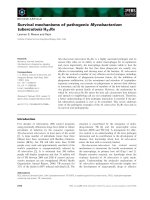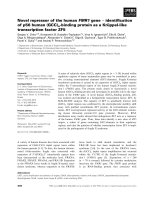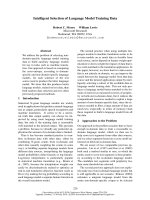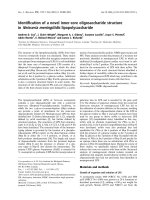Báo cáo khoa học: "Novel deployment of a covered duodenal stent in open surgery to facilitate closure of a malignant duodenal perforation" ppt
Bạn đang xem bản rút gọn của tài liệu. Xem và tải ngay bản đầy đủ của tài liệu tại đây (149.82 KB, 3 trang )
BioMed Central
Page 1 of 3
(page number not for citation purposes)
World Journal of Surgical Oncology
Open Access
Case report
Novel deployment of a covered duodenal stent in open surgery to
facilitate closure of a malignant duodenal perforation
Philip F Lung, Adrian B Cresswell, Josephine Psaila and Ameet G Patel*
Address: Department of Hepatobiliary Surgery, King's College Hospital, London, UK
Email: Philip F Lung - ; Adrian B Cresswell - ; Josephine Psaila - ;
Ameet G Patel* -
* Corresponding author
Abstract
Background: Its a dilemma to attempt a palliative procedure to debulk the tumour and/or prevent
future obstructive complications in a locally advanced intra abdominal malignancy.
Case presentation: A 38 year old Vietnamese man presented with a carcinoma of the colon
which had invaded the gallbladder and duodenum with a sealed perforation of the second part of
the duodenum. Following surgical exploration, it was evident that primary closure of the perforated
duodenum was not possible due to the presence of unresectable residual tumour.
Conclusion: We describe a novel technique using a covered duodenal stent deployed at open
surgery to aid closure of a malignant duodenal perforation.
Background
With locally advanced intra-abdominal malignancy the
surgeon is faced with the dilemma of attempting a pallia-
tive procedure to debulk the tumour and/or prevent
future obstructive complications against limiting the
impact of any surgical procedure on remaining quality of
life. Unfortunately it remains extremely difficult to assess
tumours which are adherent to local structures and the
decision must be made whether to continue anatomical
dissection or to leave the main tumour bulk in-situ and
perform a simple bypass procedure.
Case presentation
A 38 year old Vietnamese man was admitted with a 10
month history of epigastric pain, fatigue, 10 kg weight loss
and recent onset jaundice. He had no other significant
medical history. Clinical examination demonstrated
anaemia and a tender mass in the right upper quadrant of
the abdomen. A computerised tomography (CT) scan of
the abdomen revealed a 7 × 5 cm thick-walled, complex
mass adjacent to the second part of the duodenum, which
contained fluid and air and abutted the hepatic flexure of
the colon. The working diagnosis was a collection second-
ary to a colonic perforation and he was treated with intra-
venous antibiotics. He improved with conservative
management and was discharged a month later for outpa-
tient colonoscopy. The colonoscopy revealed a lesion in
the transverse colon, histology of which showed a muci-
nous adenocarcinoma.
He subsequently returned to the Accident and Emergency
Department following an upper gastrointestinal bleed. On
his second admission, a repeat CT scan again suggested local-
ised colonic perforation with formation of an abscess adja-
cent to the duodenum, along with thickening of the
ascending colon, predominantly centred around the hepatic
flexure. Given the clinical presentation and diagnostic uncer-
tainty a diagnostic laparoscopy was performed which
Published: 27 October 2009
World Journal of Surgical Oncology 2009, 7:79 doi:10.1186/1477-7819-7-79
Received: 17 February 2009
Accepted: 27 October 2009
This article is available from: />© 2009 Lung et al; licensee BioMed Central Ltd.
This is an Open Access article distributed under the terms of the Creative Commons Attribution License ( />),
which permits unrestricted use, distribution, and reproduction in any medium, provided the original work is properly cited.
World Journal of Surgical Oncology 2009, 7:79 />Page 2 of 3
(page number not for citation purposes)
revealed a large perforated tumour at the hepatic flexure with
ascites and peritoneal tumour nodules. A laparotomy was
performed via a transverse incision and following mobilisa-
tion of the hepatic flexure, a colonic tumour was found to
have invaded the gallbladder and duodenum with an
abscess cavity anterior to the second part of the duodenum.
At the base of the abscess cavity a large hole was apparent in
the second part of the duodenum with malignant tumour
invading the duodenum. Given the size of the defect (5 cm ×
2 cm) and the presence of tumour it was not possible to
resect and form a primary closure of the duodenum. The
presence of metastatic spread precluded a curative resection
by pancreatoduodenectomy.
A right hemicolectomy was performed to debulk the
tumour and an ileotransverse anastamosis formed. Due to
the extent of the disease and associated abscess the ante-
rior wall of the duodenum came away with the colon dur-
ing this manoeuvre. A retrograde cholecystectomy was
carried out to resect the residual tumour invading the gall
bladder. The ampulla was identified with the aid of a tran-
scystic catheter. An 82 mm expandable covered duodenal
stent with a diameter of 18 mm (Hanarostent, duodenal/
pyloric, M.I. Tech Co. Ltd, Seoul, N. Korea) was manually
inserted through the duodenal perforation into the proxi-
mal duodenum with the distal end of the stent inserted
into D2. A small opening into the side wall of the stent
was made prior to the positioning of the stent to accom-
modate the ampulla and thus facilitate drainage of bile
within the stent. A per-operative cholangiogram con-
firmed free flow of contrast in the duodenum. The resid-
ual duodenal wall was closed over the stent and following
antrectomy a gastrojejunostomy was formed to bypass the
duodenum (Bilroth II reconstruction).
The patient was discharged 7 weeks later following a pro-
longed, but otherwise uncomplicated recovery. He subse-
quently underwent a palliative course of chemotherapy
survived for a further 18 months without gastrointestinal
symptoms, before succumbing to his disease.
Discussion
The major risk with attempting palliative resection is the
feasibility of reconstructing anatomy that has been altered
by the malignant process. In the case described separation
of the main tumour bulk from the duodenum left a perfo-
ration involving most of the anterior surface of the second
part of the duodenum. Significantly sized malignant per-
forations of the duodenum are unlikely to heal following
simple primary closure and are at risk of resulting in high
output fistulas or high level GI tract obstruction due to
disease progression. Simple duodenal closure and duode-
nal bypass in this case would not have been sufficient to
safely defunction the perforation.
Several techniques have been described for closure of
large duodenal perforations, such as duodenojejunos-
tomy, serosal and mucosal pedical patching [1-3] without
recourse to pancreatoduodenectomy. These procedures
were mainly described for patients who sustained severe
duodenal trauma, rather than in the context of malignant
perforation. All of these techniques would have been at
high risk of anastomotic leakage and/or subsequent
obstruction in this patient due to progression of the
underlying residual disease.
Covered self-expanding metallic stents have been used to
treat oesophageal leaks and fistulas with clinical success
ranging from 67-100%, with recurrent fistulas or leaks in
8-20% of patients [4-7]. Placement of duodenal stents in
malignancy has so far been described as an endoscopic
procedure [8,9] to relieve obstruction and not to aid in
sealing a duodenal perforation from tumour invasion.
These stents are effective in the palliation of symptoms of
gastric outlet obstruction in patients with a relatively short
life expectancy. However, performing a gastrojejunos-
tomy may be considered more appropriate for those with
a more favourable prognosis [10].
Conclusion
We believe that in this case, the novel deployment of a
covered duodenal stent during an open operation negated
the requirement for a major pancreatobiliary resection
and permitted safe primary closure of the malignant per-
foration. This allowed the early use of palliative chemo-
therapy and, in conjunction with tumour debulking, may
have resulted in a significant gain in symptom free sur-
vival.
Competing interests
The authors declare that they have no competing interests.
Authors' contributions
PFL helped in preparation of the manuscript and litera-
ture search. ABC helped in preparation of the manuscript
and literature search. JP helped in preparation of the man-
uscript, literature search and editing the manuscript for its
final content. AGP helped in preparation of the manu-
script, literature search and editing the manuscript for its
final content. All authors read and approved the final
manuscript.
Consent
The publication of this case was approved by the National
Research Ethics Service, King College Hospital Research
Ethics committee, as the consent from the patient and
next of kin was not possible. The copy of ethical commit-
tee approval is available with chief editor.
Publish with BioMed Central and every
scientist can read your work free of charge
"BioMed Central will be the most significant development for
disseminating the results of biomedical research in our lifetime."
Sir Paul Nurse, Cancer Research UK
Your research papers will be:
available free of charge to the entire biomedical community
peer reviewed and published immediately upon acceptance
cited in PubMed and archived on PubMed Central
yours — you keep the copyright
Submit your manuscript here:
/>BioMedcentral
World Journal of Surgical Oncology 2009, 7:79 />Page 3 of 3
(page number not for citation purposes)
References
1. Walley BD, Goco I: Duodenal patch grafting. Am J Surg 1980,
140(5):706-708.
2. Yin WY, Huang SM, Chang TW, Lin PW, Hsu YH, Chao K, Tsai BW:
Transverse abdominas musculo-peritoneal (TRAMP) flap for
the repair of large duodenal defects. J Trauma 1996,
40(6):973-976.
3. Lee VT, Chung AY, Soo KC: Mucosal repair of posterior perfo-
ration of duodenal diverticulus using roux loop duodenojeju-
nostomy. Asian J Surg 2005, 28(2):139-141.
4. Park KB, Do YS, Kang WK, Choo SW, Han YH, Suh SW, Lee SJ, Park
KS, Choo IW: Malignant obstruction of gastric outlet and duo-
denum: palliation with flexible covered metallic stents. Radi-
ology 2001, 219(3):679-683.
5. Shand AG, Grieve DC, Brush J, Palmer KR, Penman ID: Expandable
metallic stents for palliation of malignat pyloric and duode-
nal obstruction. Br J Surg 2002, 89(3):349-350.
6. Nichol PF, Stoddard E, Lund DP, Starling JR: Tapering duodeno-
plasty and Roux-en-Y duodenojejunostomy in the manage-
ment of adult megaduodenum. Surgery 2004, 135(2):222-224.
7. Morgan R, Adam A: Use of metallic stents and balloons in the
esophagus and gastrointestinal tract. J Vasc Interv Radiol 2001,
12(3):283-297.
8. Seo EH, Jung MK, Park MJ, Park KS, Jeon SW, Cho CM, Tak WY,
Kweon YO, Kim SK, Choi YH: Covered expandable nitinol
stents for malignant gastroduodenal obstructions. J, Gastroen-
terol Hepatol 2008, 23(7 pt 1):1056-62.
9. Yoon CJ, Song HY, Shin JH, Bae JI, Kichikawa K, Lopera JE, Castaneda-
Zuniga W: Malignant duodenal obstructions: palliative treat-
ment using self-expandable nitinol stents. J Vasc Interv Radiol
2006, 17(2 pt 1):319-26.
10. Jeurnunk SM, van Eijck CH, Steyerberg EW, Kuipers EJ, Siersema P:
Stent versus gastrojejunostomy for the palliation of gastric
outlet obstruction: a systematic review. BMC Gastroenterology
2007, 7:18.









